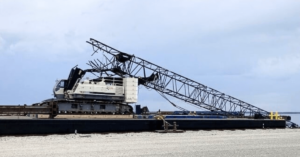
Somali Pirates Hijack Yemeni Fishing Vessel Off Horn Of Africa
February 11, 2025
Indian Navy Collaborates With NewSpace To Develop ‘Loyal Wingman’
February 11, 2025

The latest report released by the National Transportation Safety Board (NTSB) has revealed that the towing vessel transporting a large crane struck Michigan’s Mackinac Bridge in May 2023 after the crew failed to verify the crane’s height.
The collision caused $665,000 in damage to the crane and $145,000 to the bridge, though no injuries or pollution were reported.
The 103-foot-long towing vessel Nickelena was moving a deck barge carrying a crawler crane from Escanaba to Sault Ste. Marie, Michigan, for a construction project.
The crane had a 160-foot-long boom with an additional 5-foot rooster sheave attachment, making its total height a critical factor for safe transit under bridges.
Before departure, barge company managers estimated the crane’s boom angle to be between 50° and 60°. Using these rough calculations, they assumed the boom height was 140 feet, which they believed was safe for passing under the Mackinac Bridge.
However, the actual boom angle was 62°, making the crane’s total height 162 feet above the water. At the time of the incident, the bridge’s clearance was only 153 feet, meaning the crane was nearly 10 feet too tall to pass safely.
As the Nickelena approached the Mackinac Bridge at 8 knots, the crane’s securing wires made first contact with the bridge’s stiffening truss, positioned about 155 feet above the water.
The wires snapped, causing the boom to shift backwards. As the barge continued forward, the boom struck the upper diagonal truss at 183 feet before finally collapsing onto the barge’s aft end.
The engineer on board the tow vessel was outside on deck, and another crewmember was at the helm at the time of impact. Neither crew member heard the initial contact, but they later noticed the crane boom was missing when they looked back.
The NTSB investigation revealed major lapses in safety checks. The captain and the company managers did not properly confirm the air draft of the crane or the bridge’s vertical clearance. Instead of taking accurate measurements, they relied on visual estimates and incorrect calculations.
A Load Moment Indicator (LMI), which could have provided the correct boom height, was not working. LMI is a safety device used in cranes and other lifting equipment to prevent overloading and tipping accidents.
It continuously monitors the load being lifted, the boom angle, and the operating radius to calculate the load moment – the force exerted by the lifted weight at a given distance from the crane’s base.
If the crane approaches its maximum safe capacity, the LMI triggers alarms or automatically restricts further operation to prevent accidents.
Despite this, no efforts were made to measure the crane’s height. The managers also chose not to lower the boom, fearing it would reduce the barge’s stability.
The company operating the Nickelena, Basic Towing Inc., told investigators that they had a Towing Safety Management System (TSMS) in place. This system should have included voyage planning and clearance verification.
However, the NTSB found no documentation showing that a navigation assessment was conducted before departure. The captain did not take any steps to confirm whether the crane was safe to pass under the bridge.
Instead, he relied on the barge company managers, who told him, “Everything’s secured, ready to go.”
At the time of the accident, water levels under the Mackinac Bridge were higher than usual, reducing the normal 160-foot clearance to 153 feet. However, investigators concluded that even with normal clearance, the crane boom still would have been too tall to pass safely.
The NTSB determined that the boom needed to be at an angle of about 55° to clear the bridge’s vertical height at the centre of the channel. The manager’s visual evaluation underestimated the boom length by 20 feet, leading to the miscalculation.
The NTSB highlighted that the vessel operators must use accurate navigational data, consult official charts, and verify bridge clearances before departure, especially for tows with high air drafts, like crane barges.
According to the NTSB report, operators should use official navigational resources, such as the U.S. Coast Pilot and charts, to ensure they have precise data on bridge heights before transit. They added that visual estimates are not reliable for ensuring safe passage under bridges.
Reference: NTSB
Source: Maritime Shipping News


